Today, the task of preparing a new pilot for operational duty on the UK's Westland/Boeing Apache AH1 attack helicopters takes more than three-and-a-half years to complete. But by using a series of technological advances - and the future introduction of a new training aircraft - the Army Air Corps is looking to boost both the effectiveness of its instruction and accelerate this schedule.
Flight International was given exclusive access to the Army Aviation Centre at Middle Wallop in Hampshire, to hear from the officials in charge about their ambitions for the next three decades of rotary-wing activity.
This will be heavily influenced by the outcome of a contest to modernise the UK's current tri-service mechanism, via the Military Flying Training System (MFTS) programme. The Army Air Corps (AAC) has a current operational fleet of about 160 helicopters, according to Flightglobal's HeliCAS database. These range in size from the Eurocopter Gazelle and Westland Lynx to the Bell 212 and Apache. It also has a fleet of fixed-wing surveillance aircraft, comprising Britten-Norman BN-2 Islanders and Defender 4000s.
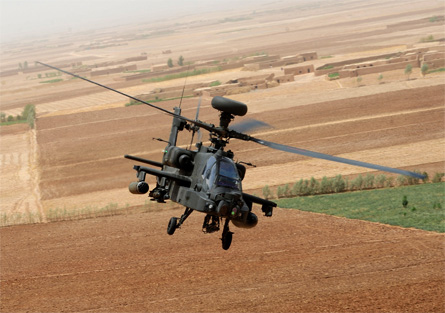 |
|---|
| © Sgt Alison Baskerville/Crown Copyright Apache operations in Afghanistan are the main focus for training activities |
The army's helicopter inventory outnumbers that of its fellow UK services, the Royal Air Force and Royal Navy. Its demand for new helicopter pilots is also currently the largest, accounting for roughly 65 students from a typical total of 140, who receive instruction at the FB Heliservices-run Defence Helicopter Flying School (DHFS) at RAF Shawbury in Shropshire each year.
While the long-term effects of the UK's Strategic Defence and Security Review of late 2010 are yet to be fully felt in terms of training demand, Army Aviation Centre commandant Col Murray Whiteside expects the current trend to persist. "The army is still going to be the biggest rotary pilot customer in the training environment right out to 2020," he says.
The process for becoming an army pilot is complex, with candidates first graded at Middle Wallop using the Grob G115 Tutor, before gaining more fixed-wing experience at RAF Barkston Heath in Lincolnshire.
After completing the DHFS course at Shawbury using the Eurocopter Squirrel HT1, they return to Middle Wallop for an operational training phase with 670 Sqn, which uses nine enhanced Squirrel HT2s. After earning their wings, pilots undergo conversion to type and conversion to role training at the site before joining their frontline units.
"The [training] pipeline has been looked at endlessly," says Whiteside. "We all know it is not as efficient as it should be, and the MFTS era must fix this."
Students arrive at 670 Sqn with about 120h of flying experience, and will log around 92h more over a 22-week course.
Each intake is of roughly 10 students, with annual throughput typically being about 40-50 per year.
"They arrive here and we try to unmould their tri-service learning," says Royal Navy Lt Andy Higgins, the squadron's second in command. Early emphasis is given to map reading as an army aviator, for example.
Sorties flown from Middle Wallop are busy, due to the congested local airspace. The Ministry of Defence's Boscombe Down test centre in Wiltshire is nearby, as is the UK's military low-flying area 1 and danger areas on the Salisbury Plain Training Area. "Straight away the cockpit workload is huge," says Higgins.
"We benefit hugely by the proximity of Middle Wallop to the Salisbury Plain Training Area, and are also slap-bang in the middle of the rotary region of all Joint Helicopter Command [JHC] main operating bases," says Whiteside. "It's a step-change from the 'sticks and poles' at Shawbury."
The safety of rotary-wing operations has recently been enhanced through the introduction of a deconfliction tool, which was funded by the JHC.
Using a PC-based centralised aviation data service (CADS) developed by UK company BAE Systems, crews from all three services are able to plot their planned sorties and receive alerts about potential conflicts with other aircraft. The technology has been introduced to reduce the risk of incidents at night, initially over Wiltshire and Hampshire.
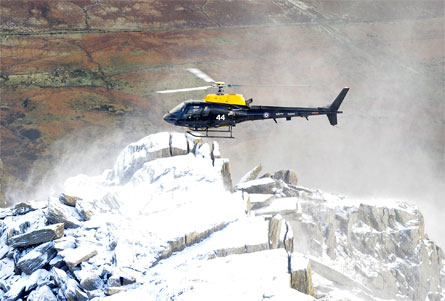 |
|---|
| © Peter Davies/Crown Copyright The Squirrel HT2 is flown under testing conditions before pilots get their wings |
"Night flying is our tactical advantage over the enemy," says Nick Wharmby, one of five civilian instructors with the AAC's Apache-equipped 673 training squadron. "Planning was insufficient and out of date. Now it is as good as we can be, morally, professionally and legally." CADS also gives crews the ability to annotate dangers, such as wires, masts and pylons, for all to see. Future additions could include the ability to also introduce meteorological data and notice to airmen, Wharmby says.
The army is currently resisting pressure to concentrate more of its training activities at Shawbury, and Whiteside is adamant that the service needs to retain a "battlefield helicopter centre of excellence, somewhere in the rotary-wing region. This is not about Middle Wallop, this is about maintaining an output standard," he says.
The AAC is proud of its 54-year heritage, with key differences required of its pilots including their ability to command and direct weapons activity, or "fires", and also perform command and control and intelligence, surveillance and reconnaissance tasks.
For the first time as aviators, 670 Sqn students are required to plan sorties, testing their capability to act as aircraft commanders. "We are about turning out a pilot capable of operating the aircraft, and not just flying it," says Lt Col Jules Facer, commanding officer of the AAC's 7 Regt training organisation. "We are asking the students to step up a lot earlier," adds Higgins. "But doing more on the Squirrel saves money on the Lynx and Apache."
Advances have already been introduced to "download" training, with several new capabilities integrated with the Squirrel HT2.
These include a moving map, a dummy defensive aids system panel to teach frontline procedures and the installation of night vision goggle-compatible anti-collision lighting, to support formation flying at night.
Reflecting the operational demands of the Apache, great emphasis is placed on flying during the hours of darkness, with 670's aircraft typically being flown four nights a week for 50 weeks of the year.
Mid-way through the course, the unit's students and aircraft are deployed to participate in a mountain flying phase, conducted from RAF Valley on Anglesey in north Wales.
Beyond this point, the unit's activities are concentrated on meeting the needs of operating in Afghanistan, such as tactical low-level and formation flying and directing joint fires, plus basic instruction in electronic warfare - all before securing their wings.
"It is all as a result of Operation 'Entirety'," says Higgins, referring to the army's current focus of attention in Afghanistan.
"Situational awareness is very important, as they can be flying down to 10ft [3m] and can only see three fields ahead," he says.
After a test in the aviation command and tactics trainer, the entire course participates in a "Cobra Strike" exercise in Wales or Yorkshire, flying high-readiness sorties alongside Apaches and Lynx. On passing, a pilot becomes a non-combat ready aircraft commander with exposure to tactical operations. But Higgins notes that in equipment terms, "the training gap is huge" to the Apache and AgustaWestland Lynx Wildcat, deliveries of which will start next year to the army at RNAS Yeovilton in Somerset.
"We need the right aeroplane onto which we can download further training in the MFTS era," says Whiteside. Apart from its Gazelles - the last of which are due to leave use in 2018 - all of the army's helicopters are currently twin-engine designs, and its Bell 212s and Lynx also have rear crew.
The introduction of a suitable training aircraft with these characteristics - and the growth potential to support future avionics advances - would provide a welcome increase in capability. Other "wish list" items include emulating the use of advanced sensors and electronic warfare and secure communications equipment.
Now with their wings, pilots advance to either 673 Sqn to convert to the Apache, or to 671 Sqn for the Bell 212, Gazelle or Lynx. The latter delivers conversion to type and conversion to role courses lasting 12 weeks each.
 |
|---|
| © Crown Copyright Training with the Bell 212 is conducted from Middle Wallop by 673 Sqn |
The UK's Apache force is structured to have 60 frontline air crews, with 50 of these flying. As the army's only Apache training squadron, 673 has 13 aircraft at Middle Wallop and 18 instructors, including civilians. Conversion lasts eight months, during which time pilots will learn to operate the Apache's systems, sensors and weapons before moving on to Wattisham airfield in Suffolk.
Each course can have up to 14 students, with the army's input balanced against its frontline needs and requirements to crew its other platforms. As well as 670 Sqn graduates, the unit instructs pilots returning to the Apache after non-flying tours, and also some RAF and Royal Navy personnel.
673's operations are supported by AgustaWestland/Boeing training joint venture ATIL, and by the former's Apache contract maintenance service.
The demands of Afghanistan have seen the type of pilot converting to the Apache change markedly since its introduction.
"The first conversion to type course in 2004 was 5,000h Lynx pilots with Northern Ireland experience. Now we have a 250h Lieutenant," says 673 Sqn commanding officer Maj Rich Youngs. "It's difficult to expect them to get everything right first time." In most cases officers are trained in the front seat to operate the sights and sensors and be the mission commander. The handling pilot will usually fly the aircraft from the back seat.
 |
|---|
| © Sgt Alison Baskerville/Crown Copyright |
Salisbury Plain is the location for much of 673's live flying training, around half of which is performed at night. In total, about 50% of its total course time is using simulators.
If, as expected, activities in Afghanistan reduce post-2015, increased training emphasis will be given to ensuring a broad skill set, such as in performing embarked operations from naval vessels, says Youngs.
"We are really leaning on innovative technology and looking aggressively at the live/synthetic balance," says Whiteside. "Helicopters are expensive to operate, and we are seeking at every turn to utilise the technology that's out there in terms of simulation, to reduce cost and improve output. But there is an irreducible minimum of live flying hours beyond which we must not go."
Pointing to the advances made by the AAC through initiatives like modifying its Squirrel HT2s and introducing the aviation command and tactics trainer, Whiteside is vociferous in his belief that the army should have a say in decisions about future aviation equipment choices for the UK armed services.
"We are the biggest stakeholder, so we must be heard and listened to with respect to our requirements in the MFTS era," he says
TECHNOLOGY
FROM iPADS TO VIRTUAL REALITY, EQUIPMENT INVESTMENT PAYS DIVIDENDS
The UK Military Flying Training System programme should field a new generation of rotary-wing training equipment from around mid-decade, but the Army Air Corps (AAC) is already introducing its own technologies.
In a bid to narrow the gap between its legacy training aircraft and the cockpit environment experienced with the Westland/Boeing Apache AH1 attack helicopter, the Army Aviation Centre at Middle Wallop in Hampshire is now using several new systems.
A first course of students has been issued with a potentially transformational, but surprisingly mainstream piece of equipment in a trial intended to support their completion of the operational training phase on 670 Sqn. Staff at the centre began to investigate options for an innovative training advance in June 2010, after funding was made available. Inspired by the use of electronic flight bags in the commercial aviation sector, they looked at means of replacing the roughly 7.5kg (16.5lb) of paper manuals that students receive on joining the unit before flying its Eurocopter Squirrel HT2s.
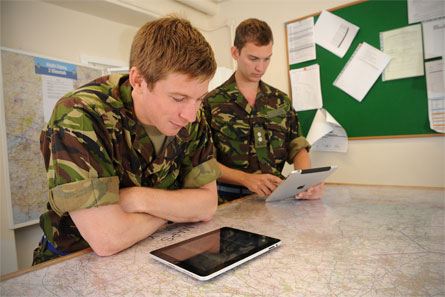 |
|---|
| © Army Air Corps iPads allow students on 670 Sqn to swiftly access more than 100 key documents |
Issued at a cost of almost £700 ($1,080) per person, some of the technical documents last for the entire eight-month course, but others are "throw-away" items that must be replaced around every 10 weeks to maintain currency.
"We soon came to the conclusion that a tablet-based device was the answer," says Maj Al Rickers, training officer for 670 Sqn. The plan was endorsed in January, and the unit took delivery of 32 iPad 1s in May.
The new equipment is primarily being used during the self-study and pre-planning phases, with students able to immediately access more than 100 unclassified documents saved in pdf format and catalogued using the iBooks library.
Supporting videos and streaming graphics can be embedded within the documents.
"With the old way, there would be one book or disc on the squadron, or else you had to use the internet or intranet," says Rickers. "Students were restricted every way they turned." Data contained on the tablets is updated via a secure server in the squadron building, or can be modified remotely. This enables trainees to be easily issued with the latest, up-to-date manuals.
Feedback and suggestions for additional uses are being sought from the students, with Rickers seeking to produce "a true and honest report". Its findings could lead to the technology being embraced elsewhere in the helicopter training system, he believes.
Instructors are the only personnel allowed to take their iPads into the aircraft for a training sortie, where they can call up data about unfamiliar landing sites, calculate changes to the Squirrel's centre of gravity, or check on the planned activities for a sortie. The device has also been trialled on the ground as a moving map. According to Rickers, perceived equipment shortcomings with the iPad are being disproven by its use. Concerns over battery life are negated by a combined 20h capacity if the same equipment was carried by both members of a two-person crew. Standards and procedures would also be in place in the unlikely event of a double failure. The use of iTunes to load data means all documents must be unclassified, but by potentially using the UK's secure Defence Information Infrastructure this could be overcome.
Should a device be misplaced, lost or stolen, a course co-ordinator can use a 'Find My iPhone' app to locate and call it, or permanently wipe all of its data while retaining the ability to track it. Once recovered, it can be reconfigured within around 5min.
Early feedback from the students has been overwhelmingly positive. "We are struggling now to find things that it can't do," says Rickers. The cost advantage is also clear, he adds: "The iPad costs £400, so from the second year we would be looking at a 100% saving."
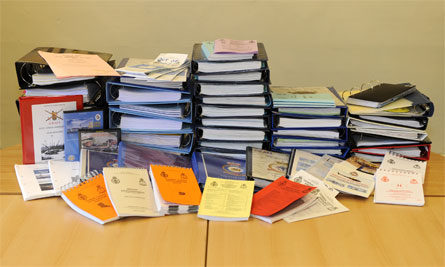 |
|---|
| © Army Air Corps Students have traditionally been issued with a mountain of paperwork |
The centre also now boasts an aviation command and tactics trainer (ACTT), in which students and frontline crew can plan and fly simulated sorties, ranging from local training flights to combat missions. With 12 work stations and visual databases of southern England, Wales and Afghanistan, the ACTT is used to instruct pilots from the three training squadrons at Middle Wallop. It also supports the mission commander course for the Apache, allowing pilots to direct other aircraft and liaise with forward air controllers.
The Rockwell Collins equipment also facilitates squadron-level practice missions and pre-deployment training for Afghanistan by replicating the crew stations of up to six Apaches. It can also be reconfigured to represent the Westland Lynx and other Joint Helicopter Command aircraft.
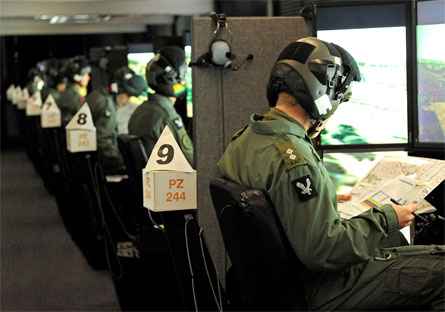 |
|---|
| © Army Air Corps The ACTT equipment can simulate a mission with six Apaches |
A virtual reality rear crew trainer for AAC utility helicopters is being leased from Australian company Virtual Simulation Systems.
"For a student's purposes, it's like being in an aircraft," says Corporal instructor Gaz Bottomley. "This is bringing through a lot of the procedures, so you can just get in the real aircraft and get the job done."
OPERATIONS
LIBYAN DUTY HIGHLIGHTS APACHE'S ROLE BEYOND AFGHANISTAN
Since entering service in 2001, the British Army's Westland/Boeing Apache AH1 attack helicopters have accumulated more than 100,000 flying hours. Over one-third of this total has been clocked up by aircraft deployed to Afghanistan, as part of the UK's Operation Herrick contribution to the NATO-led International Security Assistance Force.
The Army Air Corps has sustained a continuous Apache presence in Afghanistan since 2006, with the aircraft's crew members now spending up to 8h each day in the cockpit. Five of its aircraft also recently completed a first combat deployment at sea, having been flown from the Royal Navy helicopter carrier HMS Ocean as part of a multinational campaign to protect Libyan civilians.
A combination of advanced targeting sensors, communications equipment and an arsenal comprising a 30mm cannon, Bristol Aerospace CRV-7 unguided rockets and Lockheed Martin AGM-114 Hellfire air-to-surface missiles has seen the Apache become the UK's most formidable battlefield asset.
 |
|---|
| © Crown Copyright Five attack helicopters were deployed aboard HMS Ocean |
The UK acquired 67 of the aircraft, each equipped with a Lockheed/Northrop Grumman Longbow mast-mounted fire control radar and Rolls-Royce/Turbomeca RTM322 engines. Deliveries were made between 2000 and 2004.
"The army is extremely proud of the fact that we have fielded this vital capability for defence," says Col Murray Whiteside, commandant of the Army Aviation Centre at Middle Wallop, Hampshire.
In addition to its continued key role in Afghanistan, Whiteside believes the Apache's recent success over Libya provides a pointer to potential future maritime use of the type. "In terms of global projection, we have a capability now that we can deploy and operate in the congested littoral environment anywhere in the world," he says. "It should help bridge any gap in carrier strike certainly out for the next 10 years, and probably longer."
Source: Flight International
















